1 Introduction
There is a wide consensus about the necessity of sustainable development, and biomimetics is widely regarded as being a part of the solution. It brings together the efficiencies and self-sustaining qualities found in nature to sustainably respond to the complex challenges of this evolving world. In 2011, the Fermanian Business & Economic Institute (FBEI) at Point Loma Nazarene University provided a unique look at the Da Vinci Index, the first economic index measuring scientific research, patents and grant awards and other movements in the biomimicry sector. In 2019, FBEI has made collaboration with the Key Laboratory of Bionic Engineering (KLBE) at Jilin University aiming to analyze the biomimetics activity in China, and the Da Vinci China Index was successfully released at the opening ceremony of the ICBE 2019 organized by the ISBE.
ISBE created the bionics library in 2015 and offers information of institutions, papers, books, patents etc. Since 2016, some research analysis concentrated on scholarly papers has also been carried out, and the initial purpose is to provide Society members with biomimetic information. Based on the accumulated work in recent years, the system analysis has been further conducted by the ISBE in 2020 to reveal the ranking of countries/regions, universities, journals and research areas in the field of biomimetics. Different from the Da Vinci Index focusing on economic analysis, the current report is from an academic perspective and mainly providing specific reference to scholars.
2 Methods
For this report, Thomson Reuters Web of Science Database (WOS) was taken as the source of publications. Data were tracked during May of 2020 to retrieve publications of the year 2019. Topic including the title, abstract and keywords were taken as the searching fields. Keywords tracked included biomimicry, biomimetic, biomimetics, biomimic, bio-inspired, bioinspired, bionic, nature-inspired, biologically inspired, bioinspiration, bio-inspiration, and biomimicking. The original analyzing results of countries/regions, institutions, source titles and research areas were exported and purified. The ranking of different countries/regions, universities, journals and research areas were generated based on the final number of published papers.
3 Results
The total number of research papers retrieved in 2019 was 7915 with 109 highly cited papers and 13 hot papers. The growth trend indicated that biomimetic research has been gaining its universal relevance during the recent past and maintains an annual growth rate of about 6% (Table 1). The terminology “biomimetic” has always been the most commonly used keyword in the field, while the keywords biomimic, bioinspiration, bio-inspiration, and biomimicking were seldom used.
Table1 The number of biomimetic research papers retrieved in WOS
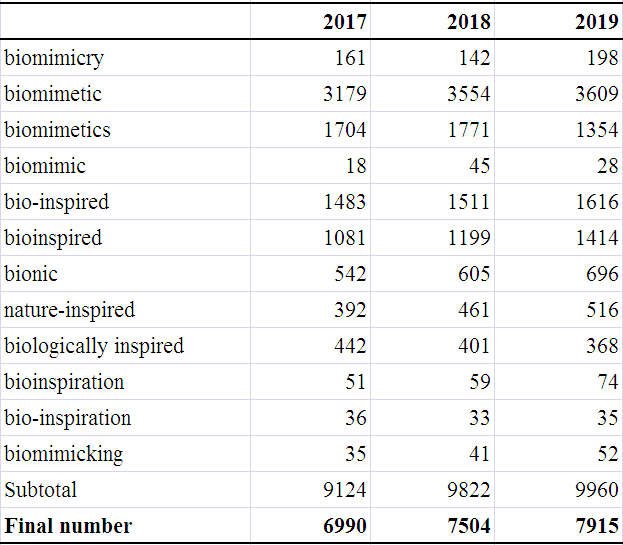
Note: Final number is smaller than the subtotal because of the duplicated papers tracked by different keywords.
3.1 Countries/Regions Distribution
In 2019, there are 108 countries and regions in total involved in the publishing of biomimetic research papers, among which the top 20 covers over 85% of the total papers, while the rest countries and regions only accounted for nearly 15% (Fig 1). The top 10 countries are mainly distributed in China, the United States, the United Kingdom, India, Germany, South Korea, Italy, France, Australia and Japan (Table 2).
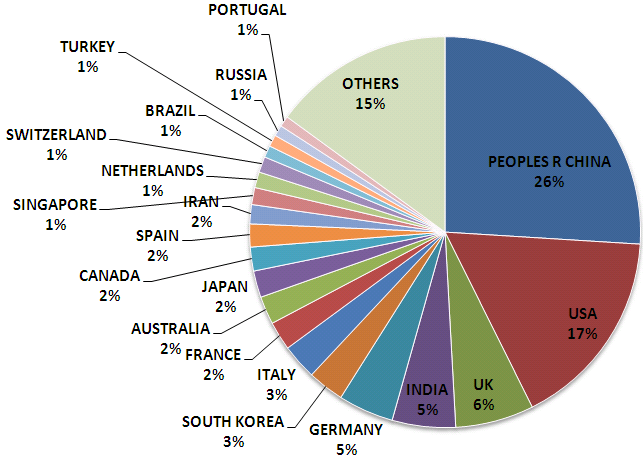
Fig 1 Distribution of biomimetic research papers among different countries/regions in 2019
Table 2 The top 25 countries/regions in 2019 based on the number of published biomimetic papers
(The number includes co-authored papers)
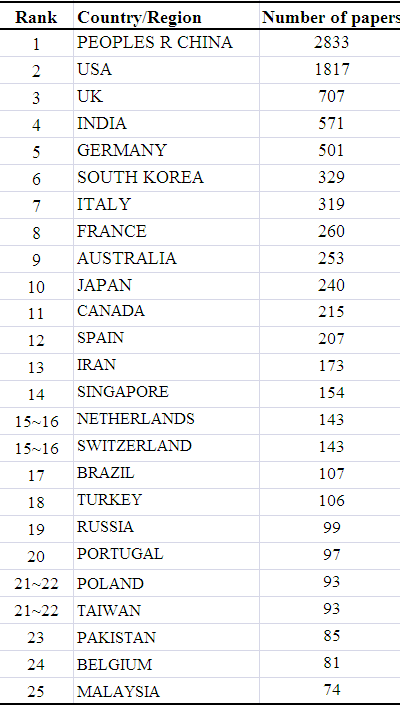
3.2 Universities Distribution
There are 25 universities in total publishing 50 or more biomimetic research papers in 2019. The top 10 universities are University of Chinese Academy of Sciences (CAS), Jilin University, Tsinghua University, Shanghai Jiao Tong University, Zhejiang University, Beihang University, Sichuan University, Harvard University, Xi An Jiaotong University and Tianjin University (Table 3). According to the results, more than half of the top 100 universities are from China and the United States, in which China has 49 and United States has 23 (Fig 2).
Table 3 The top 25 universities in 2019 based on the number of published biomimetic papers
(The number includes co-authored papers)
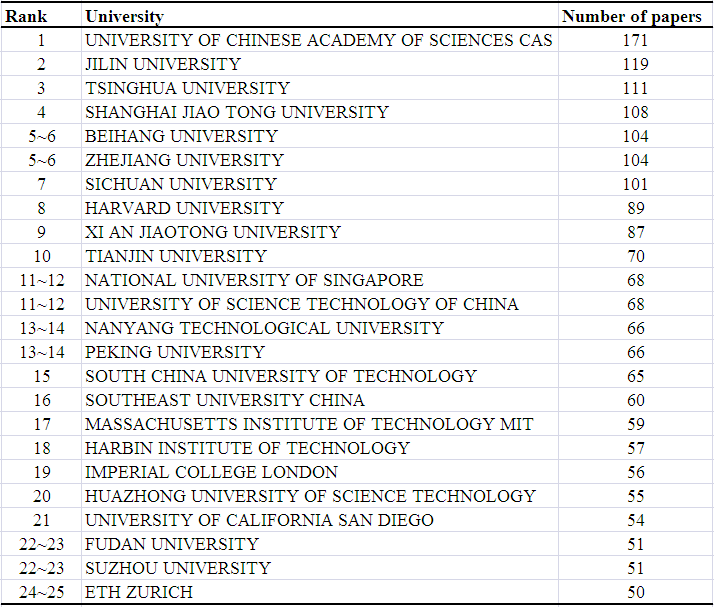
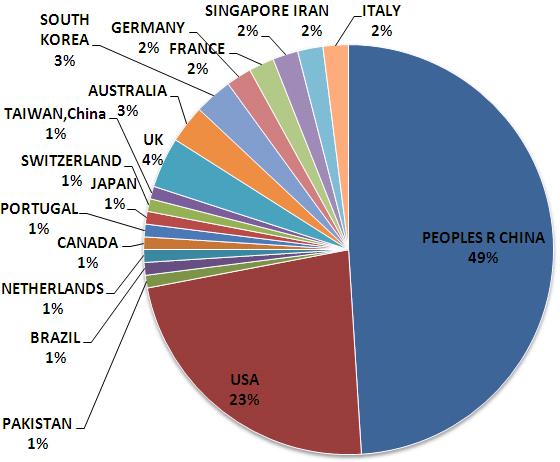
Fig 2 Distribution of top 100 universities among different countries/regions in 2019 based on the number of published biomimetic papers
3.3 Journals Distribution
Based on the statistics of source titles, the top 20 journals are shown in Table 4. It can be seen that in recent years more and more biomimetic achievements have been published in the high-level journals such as Advanced Materials, Advanced Functional Materials, ACS NANO etc., indicating that bimimetic research has received more and more attention from academic fields. Currently, there are 8 professional journals in total in the field of biomimetics, and 6 of them have already been included in the WOS (Table 5).
Table 4 The top 20 journals in 2019 based on the number of published biomimetic papers
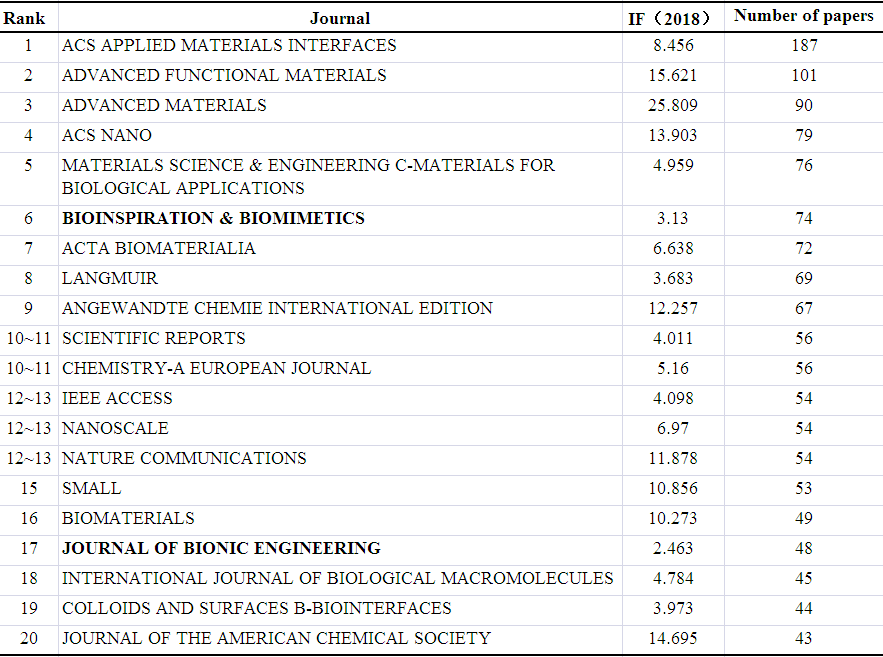
Table 5 The professional journals in biomimetics included in the WOS in 2019

3.4 Areas Distribution
In 2019, 140 research areas defined by the WOS are involved in biomimetic research, and mainly distributed in the fields of engineering, materials science, chemistry, science and technology-other topics (Table 6). Biomimetics is a highly interdisciplinary domain, and its research methods involve most of the disciplines of science and engineering. Therefore, it is of great significance to promote multidisciplinary intersection and accelerate the development of biomimetics.
Table 6 Research area distribution of biomimetic research papers in 2019
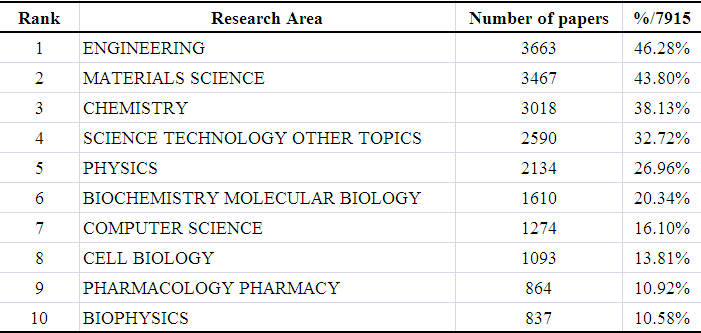
4. Conclusion
The increasing number of biomimetic research papers included by WOS indicated that the global biomimetic research activities have been steadily increasing since in recent years, and the countries and universities engaged in biomimetic research have also been on the rise. As a hotspot in scientific research in the new century, biomimetics has been attracting extensive attention of more countries and scholars and will play an increasingly important role in industrial and agricultural production, scientific and technological development, and national defense construction.
This report makes a general assessment of biomimetic research of different countries and universities based on the number of published papers, and aims to conduct a reference for cooperative research, international education and personnel training. Nonetheless, a more complete and sophisticated evaluation index system needs to be further established combined with the Da Vinci Index to measure the biomimetic activities of different countries and universities, which also account for the information of paper quality including impact factor and citation index, patents, grants and enterprise production.
Office of Secretariat, ISBE
Copyright © 2025 International Society of Bionic Engineering All Rights Reserved
吉ICP备11002416号-1









